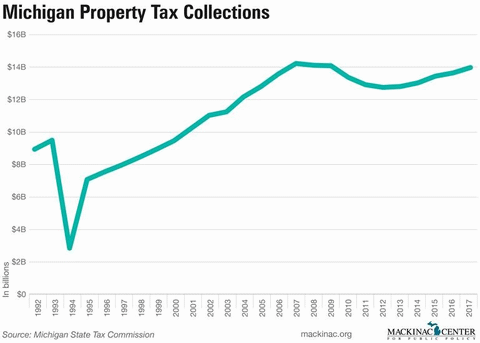City Taking In More But Manager Cries Poverty
Municipalities with growing revenue blame state for not adding even more dollars
At a town hall meeting in October 2017, Sterling Heights City Manager Mark Vanderpool echoed a refrain often heard from municipal officials and the organization that lobbies for them in Lansing. Cities, the complaint goes, aren’t getting enough of the tax revenue raised by the state, and the system for distributing that money to local governments is broken.
Vanderpool said that his city has managed to stay afloat largely due to budget cuts, reforms and two voter-approved millages.
“Cities cannot cut their way out of this ongoing crisis,” Vanderpool said. “In our case we have lost over $44 million in state shared revenue resulting in the need to eliminate over 200 full-time positions. In addition, we have eliminated pensions, retiree health care, privatized numerous services and it still was not enough.”
The city’s audited financial statements do not paint a picture of revenue decline, however.
From 2012 to 2017, Sterling Height’s total revenue increased from $93.9 million in 2012 (the equivalent of $100.2 million in 2017 dollars) to $116.1 million in 2017, a gain of $15.9 million after adjusting for inflation.
Part of that revenue increase is due to rapidly growing property tax collections. These rose from $51.7 million in 2012 ($55.2 million in 2017 dollars) to $57.3 million in 2017, a net gain of $2.1 million after inflation.
Jennifer Varney, the finance and budget director for Sterling Heights, said the increase in property tax revenue from 2012 to 2017 was entirely attributed to the passage of a street millage.
“This millage contributed an additional $6.8 million to General Fund Property Tax Revenue in fiscal 2017 and an additional $3.2 million to our Local Roads Fund which is dedicated to reconstructing neighborhood roads,” Varney said in an email. “The bottom line is that although our tax revenue has grown, it is from an increased millage, not an increase in taxable value.”
“So although State Equalized Value has increased over the time period in question, Proposal A has held down Taxable Value growth, and it is millage increases that have allowed the City to return General Fund Property Tax revenue to 2008 levels,” Varney said.
And Sterling Heights is not the only local government to collect more revenue.
The amount of property tax revenue collected by all forms of tax jurisdictions in the state rose from $12.8 billion in 2012 to $14.0 billion in 2017, according to a recently released State of Michigan report.
Still, the main lobbyist for municipal governments says there is a financial funding crisis in Michigan.
“The total amount of property tax levied in 2017 is still less than it was in 2007,” said Anthony Minghine, executive director of the Michigan Municipal League. “It is foolish to think that this allows the communities in Michigan to compete with places in surrounding states for talent. Continuing to deny that we have a broken municipal finance system in Michigan is devastating to our communities and permanently damaging our economy.”
Minghine continued: “With the exception of 2016, the average tax rate used to generate the 2017 tax levies is at the highest level of anytime in the last 20 years. This demonstrates a shift of tax burden from the state to local government and their residents. We continue to divert dollars away from local services to fund the state bureaucracy.”
Editor's note: This story was updated to include comments from the city of Sterling Heights.
Michigan Capitol Confidential is the news source produced by the Mackinac Center for Public Policy. Michigan Capitol Confidential reports with a free-market news perspective.


